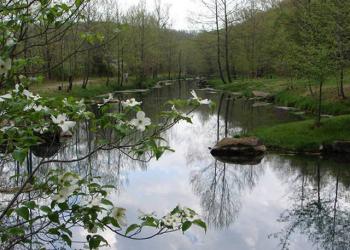Exotic and Invasive Species
Exotic invasive species are seriously affecting forest resources in the United States, alter the landscape, and disrupt critical ecosystem functions.
Exotic Invasive Species
Exotic invasive species have significantly impacted United States ecosystems and cost millions of dollars to prevent. Whether it is an insect, plant, weed, aquatic or terrestrial - exotic invasive species can have a huge impact on the ecosystem they invade.
What happens when an Invasive species is introduced to an ecosystem?
Invasive species seriously alter the landscape and disrupt critical ecosystem functions. The result can be loss and destruction of forage and/or habitat for wildlife/fish/plants, loss of available grazing land, diminished land values, lost forest productivity, reduced groundwater levels, soil degradation, increased risk of devastating wildfires, and diminished recreational enjoyment.
Entire ecosystems and communities are experiencing the detrimental impact of invasive species.
Pests such as emerald ash borer, hemlock wooley adelgid and gypsy moth have long reaching consequences for plant and tree species across the country, killing off ash, hemlock and other tree species. Infestations of non-native invasive insects can cause millions of trees to die. Non-native invasive wildlife can take over or destroy habitat for native wildlife species. Impacts to native wildlife species can then impact the forest ecosystem as natural balances are destroyed. Aquatic invaders can outcompete native and local fish populations or destroy their food source.
There are numerous research studies attempting to understand and control these pests. At present, though, it is a race against time. Will controls be found before the landscape is irreparably altered? We don't know. What we all can do, however, is to heed the warnings against moving wood. The natural progression of insects is relatively slow as long as we don't give them a ride. This is the reason for the ban on moving firewood.
How to Prevent Spreading Invasive Species
Stopping the spread of an invasive species depends on if it is plant, terrestrial animal, aquatic or weed.
What can you do to help? Do not bring firewood from home to the Mark Twain National Forest. Do not unwittingly spread the emerald ash borer, sirex wood wasp, hemlock woolly adelgid or other firewood borne invasive species. Firewood is available at or near camping facilities.
Aquatics

- Clean your boats, waders and any other equipment before leaving an area where you've been fishing/recreating.
- Eliminate any water before you transport your boat, canoe, kayak or tube.
- Clean and dry anything that came in contact with the water before you leave - including equipment, pets and even yourself.
- Don't put plants or wildlife into the water unless they came from that water.
Terrestrial/Insect/Plant
- Make sure your belongings and pets are free of mud and plant debris before you leave.
- Use local firewood for campfires - firewood can be collected from National Forests System lands near where you are camping free of charge.
- Use certified weed free hay when traveling with livestock.
- Identify a cleaning station near your destination, visit it before you leave.
- Use the boot cleaner located at most trail heads when entering and leaving a hiking trail.
Be On the Lookout!
Visit a page to find out more about the different types of exotic invasives found in Missouri, including a description, habitat, and links to more information. Where it is available we have included information on how to report an infestation.
Feral Swine
This generalist species upsets the ecological balance between native plants and wildlife by eating almost anything, causing habitat destruction and outcompeting native animals for food. They also can transmit diseases to other animals, wild and domestic. Feral swine are a public nuisance and can be aggressive toward humans, livestock, and wildlife.
Insects
There are hundreds of species of non-native insects in our forests; several species, due to lack of host resistance and lack of natural enemies, have caused significant damage to our natural and urban forests. Find out more about the invasive insects impacting Missouri.
Diseases and Pathogens
When invasive forest diseases and pathogens are introduced on trees that did not co-evolve with them the consequence is swift, dramatic, and typically fatal.
Invasive Plants
Invasive plants are among the most serious problems affecting landscapes and communities across the United States.


